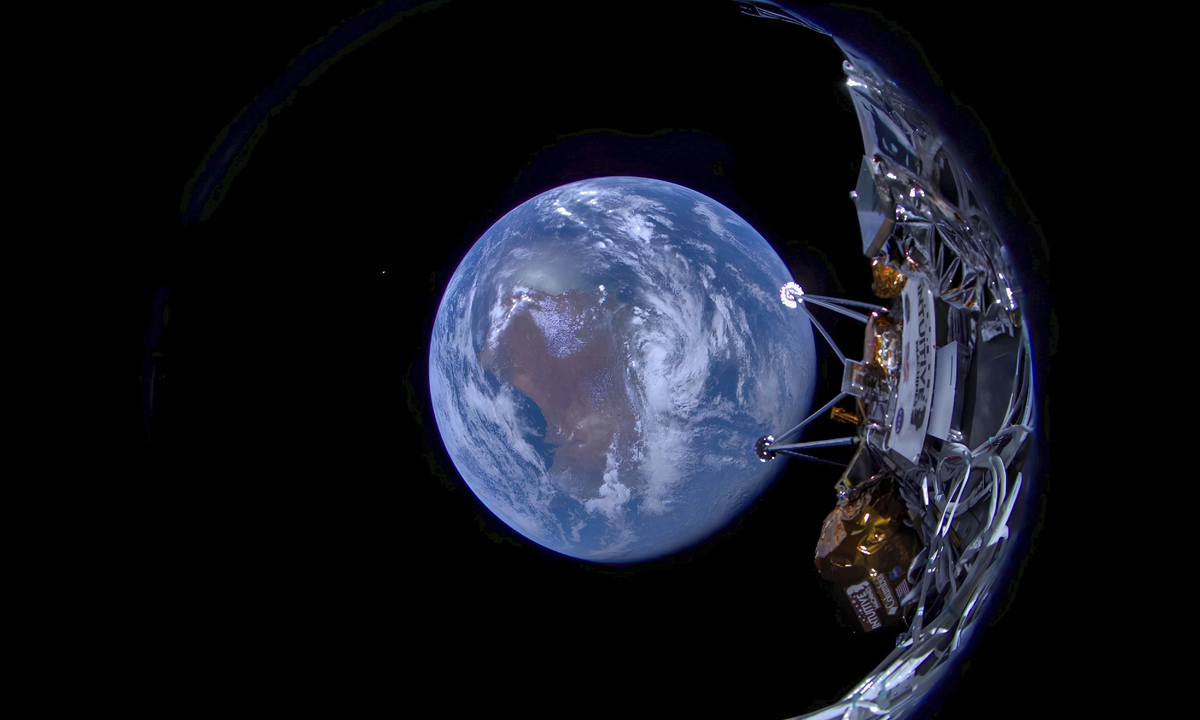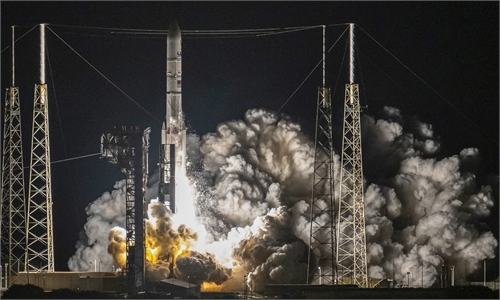
This image provided by Intuitive Machines shows its Odysseus lunar lander with the Earth in the background on Feb. 16, 2024. Photo: VCG
The historic moon landing of the Odysseus by a US firm, the first successful attempt ever made by a private enterprise, has set an inspiring example for all commercial spaceflight developers, stargazers from China said on Friday, while calling for cooperation between both countries in the field as there is great potential for complementarity in lunar data and technology.
Odysseus, a lander built by Houston-based company Intuitive Machines, made a soft touchdown near the lunar south pole Thursday local time after a nail-biting descent following a last-minute navigation sensor malfunction, Reuters reported.
It was not only a landmark moment for the US to finally land again on the Earth's nearest neighbor in more than 50 years, but also for the world as it was the first ever moon landing achieved by a private company.
The Odysseus mission is part of a NASA program called Commercial Lunar Payload Services (CLPS), which is expected to pave the way for the Artemis lunar exploration program, and deliver instruments to the moon at a lower cost than the US space agency's traditional methods.
It has been reported that NASA invested $118 million in the Odysseus mission. Its $108 million funding for Peregrine, the first mission contracted by CLPS with a private company, went down the drain when the probe suffered a crippling fuel leak hours after launch in January.
Some have wondered why it has been so difficult for the US to return to the moon. Kang Guohua, professor of aerospace engineering at Nanjing University of Aeronautics and Astronautics, noted that the US' current lunar landing technology is no longer following the old path, but rather a new beginning that combines the strengths of the government and the private sector.
"By allowing private ventures into the game, the difficult moon comeback reflected a hollowed-out American industrial sector, where even if the blueprints of the past were available, the suppliers are long gone. From another perspective, however, with the accumulated talent and experience, private companies are gradually becoming a pillar supporting a significant portion of the US' space industry, by utilizing rockets, lunar landers and crewed spacecraft," Kang said. "It has provided a new model for commercial space endeavors worldwide."
Nevertheless, NASA's way of relying more on smaller and less experienced companies still has a bumpy road ahead. Experts pointed out the dilemma for this model: As a project is usually co-developed by several ventures, there is a wide gap in the technological capabilities among them and high requirements to support such deep-space endeavors. Therefore, the question remains whether this model can prove feasible.
"Furthermore, from a commercial profit perspective, these ventures are still relying on NASA contracts to survive in the deep-space sector," Kang noted.
The landing point for Odysseus was some 186 miles from the south pole of the moon - a region that is believed to harbor lots of ice and where NASA plans to set up its Artemis bases.
The US is not the only one racing to get there. China's Chang'e-6 lunar mission, scheduled for launch in the first half of this year, is set to land at the south pole's Aitken Basin on the far side of the moon. The mission aims to bring back samples from different regions and ages to enhance human understanding of the moon.
Therefore, the room for cooperation between China and the US remains vast, such as data and technology exchange and even collaboration on space missions, Wang Ya'nan, chief editor of Beijing-based Aerospace Knowledge magazine, told the Global Times.
"Although international relations are complex at present with the relationship between the two great powers still facing uncertainty, as long as there is a need for such exchanges, they will eventually occur at some point in time," Wang noted.
He said the model used by American space companies is worth emulating. For one thing, the private companies have maintained high level exchanges of knowledge and personnel with NASA. The current CEO of Intuitive Machines, Steve Atlemus, formerly served as the deputy director of NASA's Johnson Space Center.
What's more, their strong focus on technological innovation is something Chinese firms should learn from, Wang said. "A number of cases, such as SpaceX, have proven that once you tackle a complex technological barrier which seemed challenging at first, the reward is worth the wait. We should not just aim to follow suit, but boldly venture toward more breakthroughs."


